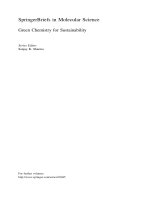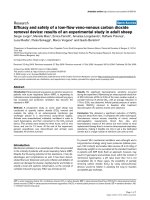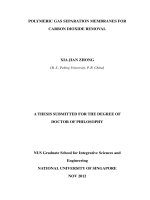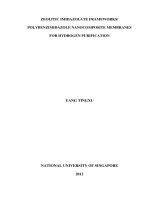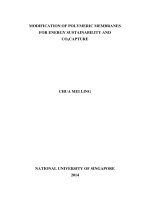Polymeric gas separation membranes for carbon dioxide removal
Bạn đang xem bản rút gọn của tài liệu. Xem và tải ngay bản đầy đủ của tài liệu tại đây (6.46 MB, 210 trang )
POLYMERIC GAS SEPARATION MEMBRANES FOR
CARBON DIOXIDE REMOVAL
XIA JIAN ZHONG
(B. S., Peking University, P. R. China)
A THESIS SUBMITTED FOR THE DEGREE OF
DOCTOR OF PHILOSOPHY
NUS Graduate School for Integrative Sciences and
Engineering
NATIONAL UNIVERSITY OF SINGAPORE
NOV 2012
To my parents and my wife for their understanding and support without any hesitation
Especially to my father for his selfless love until he left this world
i
ACKNOWLEDEGMENTS
I wish to take this opportunity to express my sincere appreciation to all the
contributors during my years in the National University of Singapore and University
of Texas at Austin. First of all, I am especially grateful to my supervisors, Professor
Neal Chung Tai-Shung and Professor Donald R. Paul, who have not only provided
guidance during my research activities but have also given generously of their time to
offer encouragement, advice and support. Their pursuance for perfection in research
and publication set a great example for my professional career. I also appreciate the
assistance from my TAC members – Prof. Hong Liang and Dr. Pramoda Kumai – for
their valuable comments and discussions. I would like to acknowledge the NGS
scholarship offered by NUS Graduate School for Integrative Sciences and
Engineering. They provide me lots of chance to attend international conferences,
summer schools and even long period of research exchange. I also wish to express my
recognition to NUS, A*Star and the Singapore National Research Foundation (NRF)
for the financial support that enables this work to be successfully completed.
It has been pleasant to work with people both in Prof. Chung’s group in National
University of Singapore and people in Prof. Paul’s group in University of Texas at
Austin. I have enjoyed the friendships with all members of these two groups,
especially Dr. Liu Songlin, Dr. Norman Horn, Dr. Xiao Youchang, Dr. Li Yi, Dr.
Rajkiran Tiwari, Ms. Wang Huan, Ms. Zhang Sui, Mr. Chen Hangzheng, Mr. Yin
Hang and many others for many good times, discussion and sharing of technical
ii
experience. Special thanks to Ms. Chuan Irene Christina for all her kindest
cooperation and help on my “2+2” exchange programme. I am also indebted to Liu Di,
Zhang Miao, Liu Jingran, Tang Zhao, Chen Xi, Yang Shengyuan for making my
graduate life joyful. Finally, I must express my deepest gratefulness to my family for
their endless support, especially to my dearest fiancee Yaqian for sharing my life in
Singapore.
iii
TABLE OF CONTENTS
ACKNOWLEDEGMENTS i
TABLE OF CONTENTS iii
SUMMARY ix
LIST OF TABLES xii
LIST OF FIGURES xiv
CHAPTER 1 Introduction 1
1.1 Membrane Technology for Gas Separations 2
1.2 History of Gas Separation Membranes 3
1.3 Applications Based on Gas Separation Membranes 4
1.3.1 Hydrogen recovery 5
1.3.2 Nitrogen Enrichment 7
1.3.3 Recovery of Organic Vapor 7
1.3.4 Carbon Dioxide Capture 8
1.4 Materials for Gas Separation Membranes 11
References 17
CHAPTER 2 Background and Approaches 22
iv
2.1 Permeability, Permeance and Selectivity 22
2.2 Solubility 24
2.3 Fractional Free volume 26
2.4 Gas Transport in Rubbery Polymers 27
2.5 Gas Transport in Glassy Polymers 28
2.6 Effect of Temperature 29
References 30
CHAPTER 3 Materials and Experimental Methods 33
3.1 Materials 33
3.2 Preparation of Dense Membranes 35
3.2.1 Preparation of Glassy Thick Membranes 35
3.2.2 Preparation of Organic-Inorganic Membranes (OIMs) 36
3.3 Preparation of Polymeric Thin Films 39
3.4 Characterization of Physicochemical Properties 41
3.4.1 Measurement of Gel Content 41
3.4.2 Fourier Transform Infrared Spectrometer (FTIR) 42
3.4.3 Transmission Electron Microscopy (TEM) 42
3.4.4 Thermogravimetric Analysis (TGA) 42
v
3.4.5 Wide Angle X-ray Diffraction (WAXD) 43
3.4.6 X-ray Photoelectron Spectrometer (XPS) 43
3.4.7 Elemental Analysis 43
3.4.8 Nuclear Magnetic Resonance (NMR) 44
3.4.9 Simulation Based on Molecular Dynamic 44
3.4.10 Variable Angle Spectroscopic Ellipsometer 46
3.5 Characterization of Gas Transport Properties 47
3.5.1 Pure Gas Permeation Tests 47
3.5.2 Mixed Gas Permeation Tests 48
3.5.3 Pure Gas Sorption Tests 48
References 50
CHAPTER 4 Liquid-like Polyethylene Glycol Supported in the Organic-inorganic
Matrix for CO2 Removal 53
Abstract 54
4.1 Introduction 55
4.2 Results and Discussion 60
4.2.1 Basic Physicochemical Properties 60
4.2.2 XRD Characterization 67
vi
4.2.3 The Gas Permeation Performance 68
4.2.5 Effect of Testing Temperature 77
4.2.5 Effect of PEGs’ Molecular Weights 81
Summary 85
References 87
CHAPTER 5 The Effect of End Groups and Grafting on the CO2 Separation
Performance of Polyethylene Glycol Based Membranes 96
Abstract 97
5.1 Introduction 98
5.2 Results and Discussion 99
5.2.1 Basic Physicochemical Properties 99
5.2.2 Gas Transport Properties of OIMs with Physical Blending 101
5.2.3 Thermal Properties of GPA1100 Series 105
5.2.4 Temperature Dependence of Gas Permeation Properties 107
5.2.5 Thermal Grafting of PEG-azide and Characterizations 112
5.2.6 Gas Permeation Properties After Thermal Grafting 116
Summary 119
References 121
vii
CHAPTER 6 Aging and Carbon Dioxide Plasticization of Thin Extem® XH1015
Polyetherimide Films 125
Abstract 126
6.1 Introduction 127
6.2 Results and Discussion 130
6.2.1 Aging Behavior Tracked by Gas Permeation 130
6.2.2 CO
2
Plasticization Pressure Curves 135
6.2.3 CO
2
Permeability Hysteresis 140
6.2.4 CO
2
Permeation Behavior for Short Exposure Times 145
6.2.5 CO
2
Permeation Behavior over Long Exposure Times 147
Summary 151
References 153
CHAPTER 7 Gas Permeability Comparison of Extem
®
XH1015 with Polysulfone
and Ultem
®
via Molecular Simulation 161
Abstract 162
7.1 Introduction 163
7.2 Results and Discussion 166
7.2.1 Chain Morphology Comparison 166
viii
7.2.2 Molecular Simulation 169
Summary 174
References 175
CHAPTER 8 Conclusions and Recommendations 177
8.1 Conclusions 177
8.1.1 Permeability and Selectivity Enhancement by Blending PEG and its
Derivatives 177
8.1.2 Permeability Enhancement by Grafting PEG-azide on the Backbone
of OIMs 178
8.1.3 Temperature Effect on Gas Permeability and Selectivity 178
8.1.4 Physical Aging and Plasticization on Polymeric Thin Films 179
8.2 Recommendations 180
8.2.1 PEG Based Organic-Inorganic Membranes 180
8.2.2 Physical Aging and Plasticization Monitored by Gas Permeability 181
Appendix A: Structure Determination of Extem
®
XH 1015 183
Results 183
References 188
ix
SUMMARY
Membrane technology has been considered as one of the most promising
candidates for selective removal of carbon dioxide from mixture with H
2
and N
2
.
Conventional glassy membranes focused mainly on the size sieving ability of
polymers. Based on the different size of CO
2
, H
2
and N
2
, the flux order of these
three gases in glassy polymers is usually H
2
˃ CO
2
˃ N
2
and these membranes are
H
2
-selective. However, the separation mechanism in rubbery membranes,
especially in poly (ethylene glycol) (PEG), is different due to the higher
contribution on solubility selectivity, which means the size sieving effect is not the
dominate factor. Therefore, the flux order of these three gases in rubber is usually
CO
2
˃ H
2
˃ N
2
and these membranes are CO
2
-selective.
Part of this project focused on exploring the possibility of using favorable
interactions between CO
2
and ethylene oxide (EO) groups to improve
permeability/selectivity properties of rubbery membranes. Organic-inorganic
membranes (OIMs) consisting of siloxane network and PEG segments were used
as the substrate. Several PEG and PEG derivatives with different molecular
weight were physically blended into the substrate before the siloxane network was
formed. The membrane containing 60wt% of 1000g/mol PEG could achieve an
x
ultra-high CO
2
permeability of 845 Barrer with CO
2
/H
2
and CO
2
/N
2
permselectivity
around 10 and 40, respectively. A PEG derivative is blended into the substrate
followed by thermal grafting. Ultra high CO
2
permeability (982 barrer at 45 ºC) is
achieved via physical blending, while extremely high CO
2
permeability (1840
barrer at 45 ºC) is obtained after chemical grafting. Neither of these two
modification methods shows the loss of CO
2
/H
2
and CO
2
/N
2
selectivity compared
to the substrate. Melting and crystallization behaviors of these PEG and PEG
derivatives are believed to significantly affect the overall gas permeation
performance.
Another part of this project focused on glassy membranes, which is also one
of candidates for CO
2
removal in industry. However, CO
2
plasticization and
physical aging on glassy membranes severely reduced their chances to be further
developed. Industrial glassy gas separation membranes usually have selective
dense layers with thicknesses around 100 nm. It has long been assumed that these
thin layers have the same properties as thick (bulk) films. However, recent research
has shown that thin films with such thickness experience accelerated physical aging
relative to bulk films. Thin films made from Extem® XH 1015, a new commercial
polyetherimide, have been investigated by monitoring their gas permeability. The
permeability of the thin films is originally greater than the thick films but eventually
decreases well below the permeability of the thick film. The CO
2
plasticization of
xi
Extem thin films is also explored using a series of exposure protocols that indicate
CO
2
plasticization is a function of film thickness, aging time, exposure time,
pressure and prior history. In order to further explore the structure/property
relationship of glassy polymers, some simulation works based on molecular
dynamics were also conducted.
xii
LIST OF TABLES
Table 1-1 Most important polymers used in industrial gas separation membrane [10]
12
Table 1-2 Progress of membranes for the O
2
/N
2
separation (25°C) [10] 12
Table 3-1 Chemical structures of polymer used in this study 34
Table 3-2 Bulk properties of polymers used in this study 34
Table 3-3 Atom numbers and cell dimensions for PSU, Extem and Ultem
amorphous cells 46
Table 4-1 Gel content (%) of GP w/o PEG and GPP series 60
Table 4-2 Thermal properties of GPP series, GP w/o PEG and pure PEGs 62
Table 4-3 Average size and area fraction of silica particles in GP w/o PEG and
GPP1500-60 67
Table 4-4 Pure gas permeability and selectivity for membranes with different
compositions at 35°C ,45°C and 55°C
a
70
Table 4-5 Gas permeability, solubility and diffusivity coefficient results compared
with PDMS and PEO from other sources 72
Table 4-6 Mixed gas permeability and selectivity for GPP1000-60 and
GPP1500-60 at 45°C 77
xiii
Table 5-1 Thermal properties of GPA1100 series 101
Table 5-2 Pure gas permeability and selectivity of OIMs blended with PEG-azide
102
Table 5-3 Solubility and diffusivity coefficients of GPA1100 and GPP1000 series
at 45 ºC 104
Table 5-4 Pure gas permeability and selectivity of GPA1100 series before and after
grafting 117
Table 7-1 Gas permeation performance of flat dense PSU, Extem and Ultem
membranes 167
Table 7-2 Kinetic diameters of various gases 171
xiv
LIST OF FIGURES
Figure 3-1 Synthetic route of Extem XH1015 33
Figure 3-2 Synthetic route of hybrid membranes 37
Figure 4-1 Concept of liquid PEGs supported in the organic-inorganic matrix 59
Figure 4-2 STEM images of (a) GPP without free PEG and (b) GPP1500-60 and
(c) EDX analysis of silica particles 65
Figure 4-3 STEM images of (a) hybrid membranes and (b) imaginary matrix
constructed with (c) different functional groups 66
Figure 4-4 STEM images of hybrid membranes after imageJ analysis: (a) GPP
w/o PEG and (b) GPP1500-60 66
Figure 4-5 XRD patterns for (a) GPP400, (b) GPP1000, (c) GPP1500 and (d)
GPP2000 at room temperature 68
Figure 4-6 Selected permeability/selectivity data map for (a) CO
2
/H
2
and (b)
CO
2
/N
2
separation at 35°C 69
Figure 4-7 CO
2
permeability of GPP series and GP w/o PEG at 35°C (blank) and
45°C (checked) 74
Figure 4-8 Permselectivity at 35°C (solid) and 45°C (hollow) for CO
2
/H
2
76
xv
Figure 4-9 DSC curves for (a) GPP400, (b) GPP1000, (c) GPP1500 and (d)
GPP2000 76
Figure 4-10 Change of CO
2
permeability of GPP1500-60 from 30°C to 55°C
80*Tm
2o
is the onset melting temperature of PEG1500 in GPP1500-60
during 2
nd
heating. 80
Figure 4-11 CO
2
Sorption isotherm (a) and solubility coefficient (b) of GPP1500 at
35°C and 45°C 80
Figure 4-12 Sorption isotherm (a) and solubility (b) of GPP1500, PDMS [52]
semi-crystalline PEO and amorphous PEO [28] at 35°C 81
Figure 4-13 Solubility (square) and diffusivity (circle) of hybrid membranes
containing 40wt% of PEG with different molecular weights at 45°C
83
Figure 4-14 Crystallization of PEO segments and PEGs with different molecular
weights 84
Figure 5-1 TEM micrography of GP w/o PEG-azide at (a) a low magnitude and (b)
a high magnitude 100
Figure 5-2 Glass transition temperature shifts of GPA1100 series by DSC 103
Figure 5-3 DSC curves of (a) 2
nd
heating and (b) 2
nd
cooling of GPA1100 series
107
xvi
Figure 5-4 The temperature dependence of CO
2
permeability of GPA1100 series
109
Figure 5-5 Temperature dependences of CO
2
sorption isotherms of (a)
GPA1100-20 and (b) GPA1100-40 111
Figure 5-6 Temperature dependence of (a) solubility and (b) CO
2
diffusivity of
GPA1100-20 and GPA1100-40 112
Figure 5-7 Temperature dependence of (a) CO
2
/H
2
and (b) CO
2
/N
2
selectivity of
GPA1100-20 and GPA1100-40 112
Figure 5-8
13
C solid state NMR spectra of (a) GPA1100-40 pristine and (b)
GPA1100-40 after thermal grafting 114
Figure 5-9 N1s XPS data before and after thermal grafting for GPA1100-40 115
Figure 5-10 TGA data of GPA1100-40 before thermal grafting 115
Figure 5-11 CO
2
solubility (open) and diffusivity (solid) of GPA1100-40 before
and after grafting 118
Figure 5-12 Wide angle XRD patterns of GP w/o PEG-azide, GPA1100-40 before
and after the grafting at ambient temperature 118
Figure 5-13 2
nd
cooling curve of GPA1100-20 and GPA1100-40 before and after
the grafting 119
xvii
Figure 6-1 DSC thermograph showing the glass-transition temperature of Extem
130
Figure 6-2 Oxygen permeability of (a) Extem films with similar thickness and (b)
Matrimid, PSF and Extem films as a function of aging time 131
Figure 6-3 (a) Oxygen, (b) nitrogen, (c) methane permeability of Extem films with
different thickness as a function of aging time 134
Figure 6-4 O
2
/N
2
selectivity of Extem films as a function of aging time 134
Figure 6-5 CO
2
sorption isotherms for thick films at 35C: Matrimid [54], PSF [55],
PPO [56], butyl rubber [53] 137
Figure 6-6 Normalized CO
2
permeability of thin films as a function of (a) pressure
(Matrimid, PPO and PSF data are taken from the literature [18])
and (b)
CO
2
concentration 139
Figure 6-7 (a) CO
2
permeability and (b) normalized CO
2
permeability as a function
of CO
2
pressure for different aging times 140
Figure 6-8 CO
2
permeability hysteresis curves of thin films aged (a) 25 hr, (b)
100 hr and 150 hr 142
Figure 6-9 CO
2
permeability as a function of time at (a) 32 atm (after increase CO
2
pressure)and (b) 4 atm (after decrease CO
2
pressure) during hysteresis
testing 144
xviii
Figure 6-11 (a) CO
2
permeability and (b) normalized CO2 permeability during
long time CO
2
exposure at different pressures 148
Figure 6-12 (a) CO
2
permeability and (b) normalized CO
2
permeability as a
function of exposure time at 8 atm for different polymer films 150
Figure 6-13 (a) CO
2
permeability and (b) normalized CO
2
permeability as a
function of exposure time at 32 atm for different polymer films 151
Figure 7-1 Chemical structures of PSU, Extem and Ultem 166
Figure 7-2 Chain morphologies of PSU, Extem and Ultem with 5 repeat units . 166
Figure 7-3 Morphology of two polymer chains with 5 repeat units for PSU, Extem
and Ultem 169
Figure 7-4 Fractional accessible volumes and relative FAV values of PSU, Extem
and Ultem, probed with different diameters 170
Figure 7-5 Correlation between gas permeability and 1/FAV 172
Figure 7-6 FAV ratios of Extem/PSU and Ultem/PSU probed by different
diameters 174
1
CHAPTER 1 Introduction
Membrane technology covers almost every aspect of separation engineering,
including solid-liquid (microfiltration, ultrafiltration) [1], ion-liquid (nanofiltration
[2], reverse osmosis [3], forward osmosis [4]), liquid-liquid (pervaporation [5]),
liquid-gas (gas contactor [6]) and gas-gas separation (gas separation [7]).
Compared to the convention separation processes, e.g., distillation or extraction,
membrane based separations are generally cost-effective, energy efficient and
environmentally friendly. Moreover, membrane separation units are modular so
that they are easy to install, operate and scale up. For example, the juice
concentration process in food industry is now dominated by membrane technology
due to the ability of membranes to remove water at room temperature [8]. Reverse
osmosis and membrane bioreactors are also very popular processes, especially, in
seawater desalination and waste water treatment, because of their high reliability
and efficiency [9]. However, gas separation membranes are relatively less popular
than other highly competitive technologies. Developing the usage of membranes
in emerging gas separation applications is a must for researchers in this field. In
this introductory chapter, several applications based on gas separation membranes
will be reviewed, and some potential applications in carbon dioxide related
separation will be discussed. Glassy, rubbery and organic-inorganic membranes
2
will be involved in the membrane fabrications and discussions.
1.1 Membrane Technology for Gas Separations
Due to the extremely small size of the separation targets, gas separation
membranes are usually thin selective barriers between two gas phases. The
gradient of the chemical potential due to the different gas concentrations in the
two phases becomes the driving force of gas diffusion across the membrane.
Today, most of gas separation membranes are in the form of hollow fiber modules,
with fewer being formed in spiral-wound modules. The hollow fiber modules are
usually less expensive than the spiral-wound modules, while the latter are usually
considered to be more reliable in terms of easy and cheap maintenance. In
principle, the permeation and separation performance of gas membranes depend
on four parameters [10]: (1) the material, which determines the intrinsic
permeability and separation factor; (2) the membrane structure and thickness,
which determine the permeance; (3) the membrane configuration, e.g., flat sheet
or hollow fiber; and (4) the module and system design. Developing a material into
a commercial product takes years to evaluate and refine the aforementioned
parameters.
3
1.2 History of Gas Separation Membranes
Long before the first commercial gas separation membranes (named Prism)
were introduced, people had already noticed the potential usage of membranes as
gas separation tools. In 1829, Thomas Graham discovered the law of gas diffusion
by using a tube with one end sealed with plaster of Paris [11]. Three years later,
Mitchell [12] reported for the first time that different gas molecules have different
tendencies to pass through rubber membranes, which means the flux of each gas is
different. Since then, lots of polymers have been studied extensively to look for
their potential to be gas separation membranes. H. A. Daynes and R. M. Barrer are
the pioneers in performing quantitative measurements of gas permeability by
using the time-lag method. A number of permeability data had been obtained from
lots of potential membrane materials [13]. However, the lack of technology to
produce high performance and low cost modules postponed the applications of gas
separation membranes, until Loeb and Sourirajan [14] invented a novel phase
inversion method to cast asymmetric cellulose acetate membranes, which enables
the reduction of effective membrane thickness from several micrometers into
sub-micrometer level. The invention of high-flux anisotropic membrane modules
in the forms of spiral-wound and hollow fiber further facilitated the development
of gas separation membranes. In 1980, Permea delivered the first generation
polysulfone hollow-fiber membranes for hydrogen recovery from purge gas
4
steams of ammonia plants. Soon after the success of Permea, Cynara (now part of
Natco), Separex (now part of UOP), and GMS (now part of Kvaerner) had
commercialized cellulose acetate membranes for removing carbon dioxide from
natural gas [15]. More recently, the Polaris
TM
membrane developed by MTR
(Membrane Technology and Research, Inc.), which is a thin film composite
membrane in spiral wound form, shows a CO
2
permeance ten times higher than
the conventional cellulose membranes [16].
1.3 Applications Based on Gas Separation Membranes
Generally speaking, membrane-based gas separation has become more and
more important compared to the conventional gas separation technologies such as
adsorption, absorption and cryogenic distillation [15]. Many common polymer
materials, such as polydimethylsiloxane (PDMS), cellulose acetate (CA),
polysulfone (PSF), polyethersulfone (PES), and polyimide (PI), had been
fabricated into membrane modules and applied to various gas separation processes
such as hydrogen recovery, nitrogen enrichment, recovery of volatile organic
compounds (VOCs), and separation of acid gases in natural gas resources and
steel industries [17].

